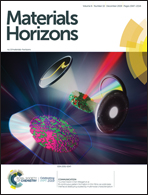Chiral biomineralized structures and their biomimetic synthesis
Abstract
Chiral, biomineralized structures are common in Nature, ranging from the nanoscale to the macroscale. Cutting across both marine and terrestrial organisms, chiral structures are tremendously diverse in their complexity and in their functions. In humans, mineral otoconia of the vestibular apparatus in the inner ear are normally faceted and not chiral, but in pathology, can be rounded and chiral (associated with vertigo). In this review, we document the ubiquity, complexity, and diversity of chiral mineralized structures found in biology. At the molecular level, it is reasonable to consider that the handedness of hierarchical chiral suprastructures of biominerals might result from the actions of homochiral biomolecules composed exclusively of L-amino acids as are generally found in Nature. However, establishing connections between chirality at the molecular scale to larger-scale synthesis and assembly has proven difficult, and knowledge on how homochiral biomolecules direct biomineral nanoparticles to form extended, hierarchical chiral architectures remains largely unknown. After reviewing chiral biomineralized structures found in Nature, a variety of synthetic models for chiral induction by molecules on mineral shape and structure is comprehensively addressed in this review. We highlight progress made towards the synthesis of biomimetic mineral structures in the laboratory setting, spanning from simple single crystals that are chiral, to hierarchically organized suprastructures created by the opposite effects of pure chiral enantiomers, and to chiral switching of hierarchically organized suprastructures induced by a single chiral enantiomer. Progress in executing such biomimetic syntheses in the laboratory is starting to approximate similar processes occurring in the complex setting of organismal biology. This discovery and applied science journey on biomineral chirality – combining knowledge on both natural and synthetic biominerals – is beginning to reveal how biological mechanisms controlling complex biomineralization processes might function in a homochiral world to create oppositely chiral suprastructures. In human physiology, such knowledge may allow us to build biomineral growth models for body components such as otoconia, and then guide therapies that may thwart abnormalities when biomineralization goes astray.



 Please wait while we load your content...
Please wait while we load your content...